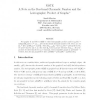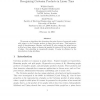30 search results - page 4 / 6 » Distinguishing Chromatic Number of Cartesian Products of Gra... |
DM
1998
13 years 7 months ago
1998
CPC
1998
13 years 7 months ago
1998
We give a characterization for isoperimetric invariants, including the Cheeger constant and the isoperimetric number of a graph. This leads to an isoperimetric inequality for the ...
DM
2010
13 years 7 months ago
2010
The Grundy number of a graph G, denoted by (G), is the largest k such that G has a greedy k-colouring, that is a colouring with k colours obtained by applying the greedy algorithm...
DM
2007
13 years 7 months ago
2007
We present an algorithm that determines the prime factors of connected graphs with respect to the Cartesian product in linear time and space. This improves a result of Aurenhammee...
COMBINATORICS
2000
13 years 7 months ago
2000
Let (G) denote the domination number of a graph G and let G H denote the Cartesian product of graphs G and H. We prove that (G)(H) 2(G H) for all simple graphs G and H. 2000 Math...


